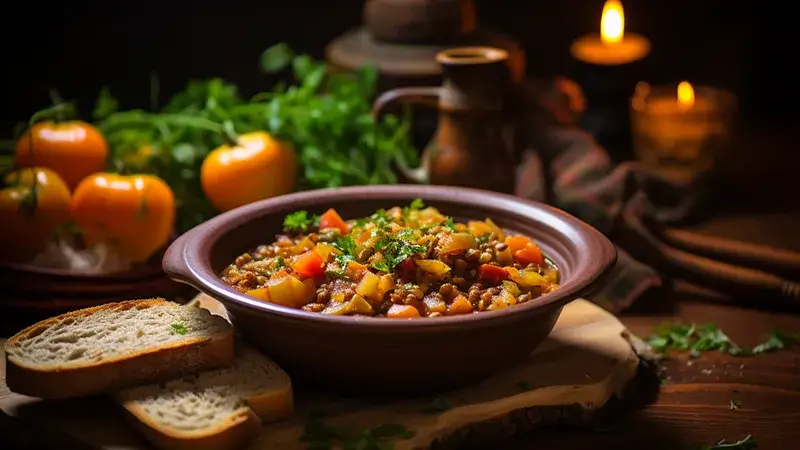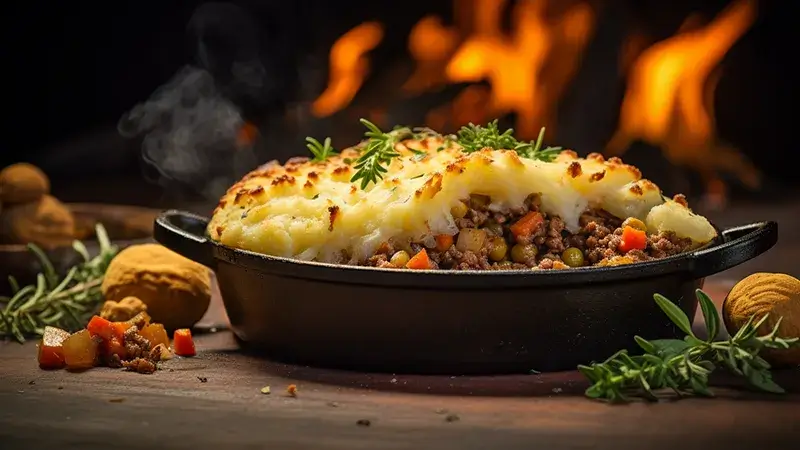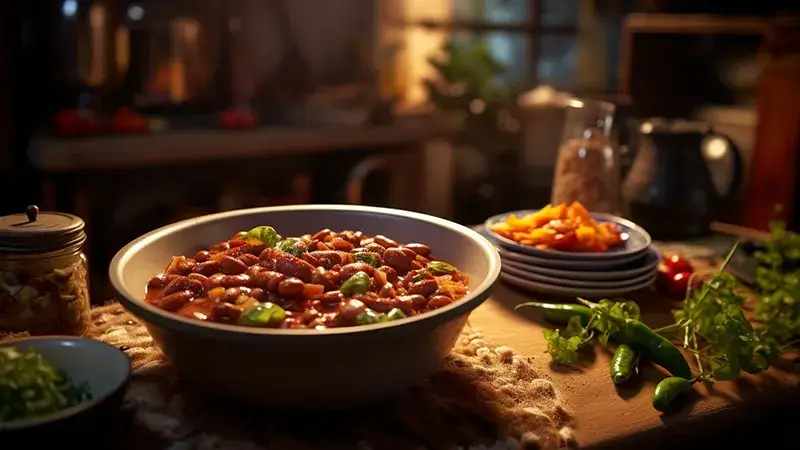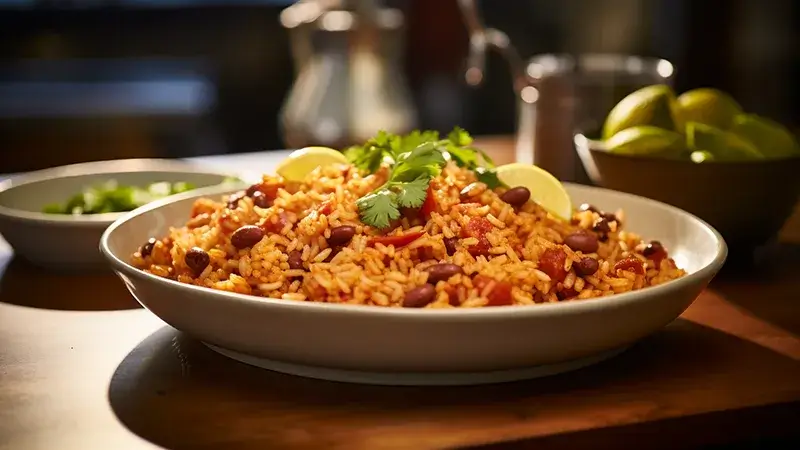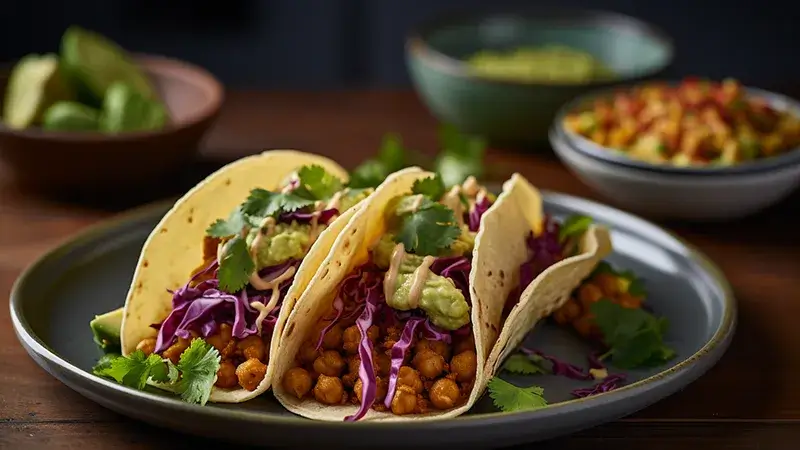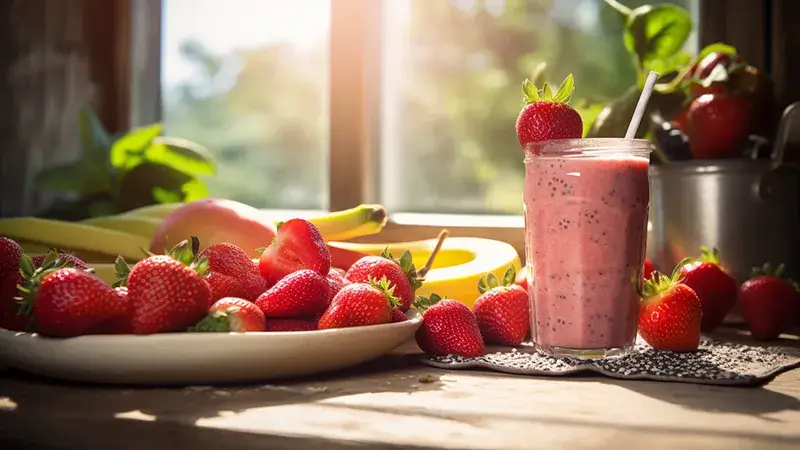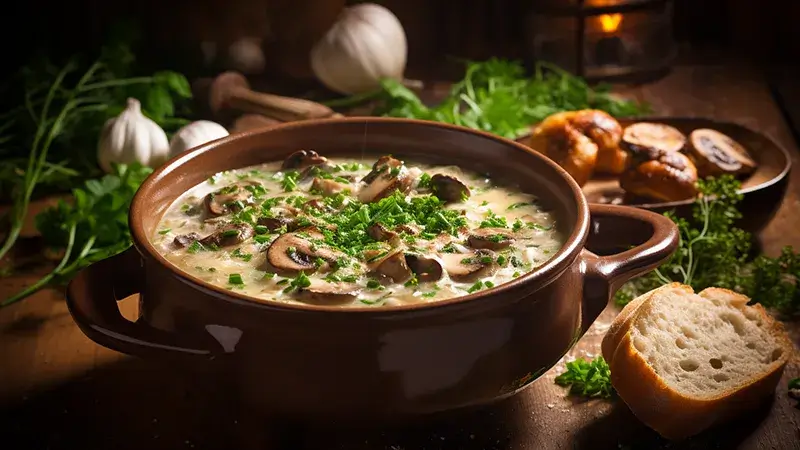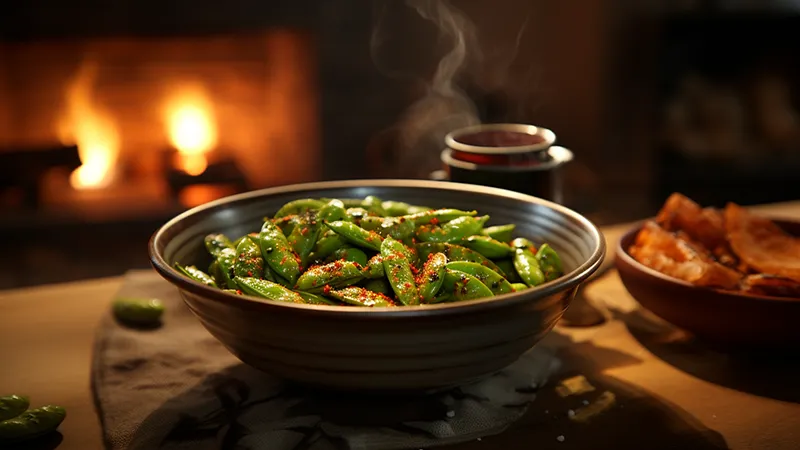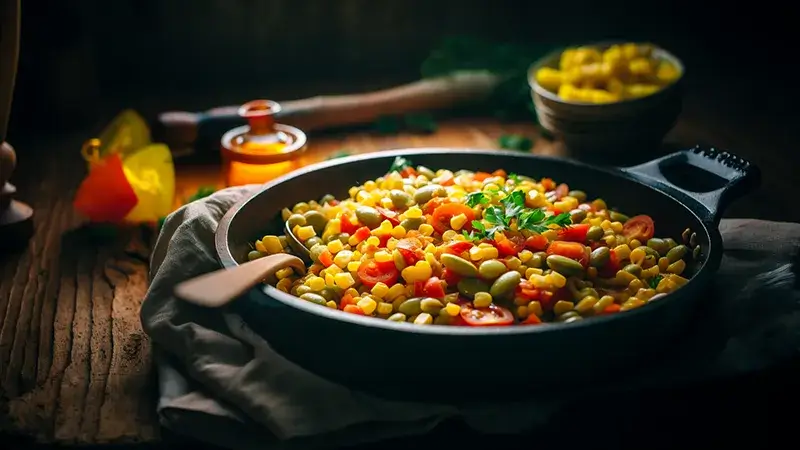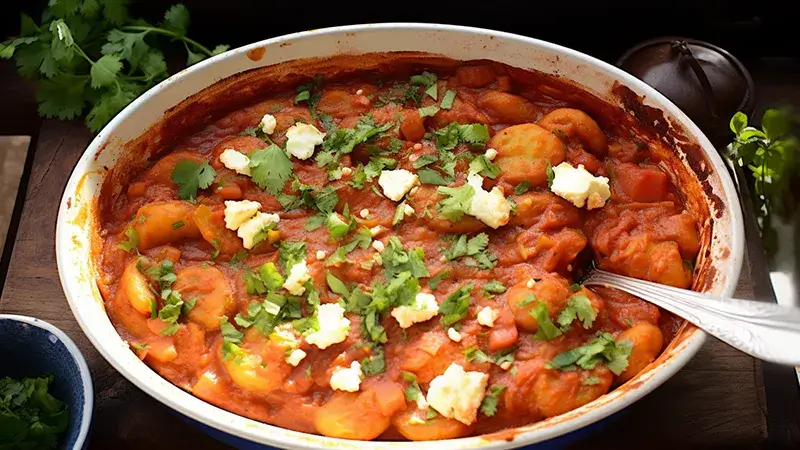Best Vegetables For Protein
We’re all on the hunt for healthy, protein-rich foods to add to our diets. Protein plays a key role in maintaining and repairing the body’s tissues, muscles, and organs. Not to mention, it keeps us feeling full longer.
But do we always have to reach for meat or dairy products for our protein fix? Absolutely not! Vegetables can be an excellent source of protein too. In fact, there are veggies that pack just as much protein punch as some traditional animal sources—without the added fats or cholesterol.
So,if you’re looking to diversify your diet or simply want more plant-based options, we’ve got you covered. We’ve done the research and compiled a list of high-protein vegetables that are both delicious and nutritious.
Let’s dive into this green goodness together!
Why is Protein Important?
Protein’s crucial because it’s not just about building muscles, it’s also key to repairing cells and making new ones. Our body requires a daily protein intake to support various functions, from the growth of hair and nails to the production of enzymes that power numerous chemical reactions within our bodies.
But did you know vegetables can be an excellent source of protein too? Not only do they offer essential amino acids needed for muscle support recovery after a workout, but also help meet our daily protein requirements. Going beyond traditional sources like meat and dairy, plant-based proteins like those found in protein-rich vegetables are increasingly acknowledged as vital for maintaining optimal health.
How Much Protein Do We Need a Day?
Depending on your lifestyle, you’ll need between 1 and 1.3 grams of protein per lb of body weight. This important nutrient each day to keep your body functioning at its optimum level.
This daily protein goal can vary significantly based on factors like age, sex, weight, and activity levels.
A diet rich in protein foods helps to meet this target by providing essential amino acids that our bodies can’t produce on their own.
Reaching our optimal protein intake isn’t just about eating a steak every day; it’s about incorporating a variety of protein foods into our meals.
Vegetables with a high protein content offer an excellent way to boost our intake while also providing other essential nutrients.
Vegetables vs Meat Protein Values
Incorporating a variety of food sources into your diet can certainly enhance your protein intake, though it’s worth noting that the nutritional value differs significantly between plant-based and animal-derived proteins.
When assessing vegetables vs meat protein values, it’s clear that some of the best vegetables for protein include peas, spinach, and broccoli - known as the highest-protein vegetables per calorie. While meat typically has higher protein percentages, plant sources offer essential nutrients not found in animal proteins such as dietary fiber.
Maintaining muscle mass requires an adequate intake of this essential nutrient. However, when considering overall health, don’t overlook the benefits of plant-based proteins. They not only contribute to meeting our daily protein needs, but also provide added nutrients promoting optimal health.
What Constitutes a High-Protein Vegetable?
You might be curious about what makes a vegetable high in protein. Well, it’s not just about the grams of protein. The nutrient content also plays a vital role.
A high-protein vegetable typically contains at least 5 grams of protein per serving, along with being a rich source of vitamins and minerals. Whilst the typical value is 5 grams, we have included a few that are below that level as they offer other benefits, and / or are great to use in your meals.
When we talk about the best vegetables for protein, we’re referring to those that provide essential amino acids, the building blocks of protein. These veggies are ideal for anyone on a plant-based or vegan diet who’s looking to maintain their protein intake.
So, when you’re compiling your list of high-protein foods, don’t forget to include these power-packed vegetables with protein! They can make an excellent addition to any healthy diet.
High Protein Vegetables
Before we delve deeper, I want to clarify that I have included Fruits and Vegetables, Legumes, Nuts, Seeds, Mushrooms and Grains ALL as vegetables. I know I know, it's kind of a cop out - but before I get emails and texts about the factually correct food categorisation of these "vegetables" - I know what they are, but commonly they are deemed veggies when it comes to cooking. So there we have it, Brett's disclaimer 😉
The idea of this article is to help us all make more informed choices about our diet and for those of us that enjoy a vegetarian or vegan lifestyle, an essential part of getting protein into our bodies via "vegetables". Without further ado, let's get tucked into the veggie list 😀
Lentils
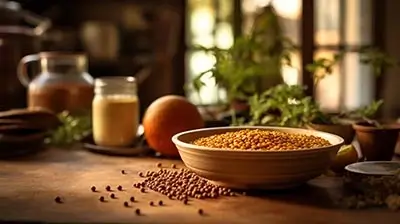
Lentils are a small, lens-shaped legume that comes in a variety of colours, most commonly green, brown, and red. Not only are these humble little legumes delicious, but they are also full of health benefits. Vegans and vegetarians alike enjoy lentils because they are a great source of protein from plants.
In addition, they contain dietary fibre, which aids digestion and maintains a healthy gut. Heart-healthy and weight-management-friendly lentils are low in fat and cholesterol, allowing them to be eaten as a heart-healthy, cholesterol-free food. Aside from being packed with essential vitamins and minerals, lentils also contain a variety of essential minerals, including iron, folate, potassium, and magnesium.
Lentils are extremely versatile when it comes to cooking and can be used in a variety of recipes. You can cook them on their own as a simple side dish, add them to soups and stews to add texture and flavour, or even use them as a meat substitute in vegetarian and vegan recipes. The hearty and nutritious component of lentils makes them a great addition to salads, curries, and grain bowls. As they have a mild, earthy taste that pairs well with various herbs and spices, they can be used for a range of flavour profiles in accordance with different cuisines and personal preferences.
Whether you enjoy them as a side dish, a main course, or a protein-packed ingredient in various recipes, lentils offer a delicious and healthy addition to any meal.
Nutritional Values For Lentils
| Name | Value |
|---|---|
| Calories (per 100 grams) | 352 |
| Protein (per 100 grams) | 25 |
| Carbs (per 100 grams) | 63 |
| Fat (per 100 grams) | 1.1 |
| Fibre (per 100 grams) | 11 |
| Sugar (per 100 grams) | 2 |
Almonds

Almonds are nutrient-dense nuts that not only taste delicious but also offer several health benefits. A rich source of healthy fats, proteins, vitamins, and minerals, almonds are also thought to improve brain function and support heart health. In addition to being great sources of vitamin E, they also act as powerful antioxidants, preventing free radical damage to our cells. A rich source of fibre, almonds promote healthy digestion and prevent constipation. Furthermore, they contain magnesium, which plays a crucial role in maintaining healthy blood pressure levels. There is no end to the culinary uses for almonds.
You can enjoy them raw as a nutritious snack, or roast, salt, or flavour them for a variety of tastes. There are several dairy-free alternatives to almond butter, milk, and oil, including almond milk and almond oil. For a crunchier and more flavourful salad, baked goods, or granola, chopped almonds can be added. Overall, almonds are not only a tasty addition to our diet but also a versatile ingredient that can be incorporated into a wide range of dishes.
Nutritional Values For Almonds
| Name | Value |
|---|---|
| Calories (per 100 grams) | 579 |
| Protein (per 100 grams) | 21 |
| Carbs (per 100 grams) | 22 |
| Fat (per 100 grams) | 50 |
| Fibre (per 100 grams) | 13 |
| Sugar (per 100 grams) | 4.4 |
Pinto Beans

Pinto beans, also known as frijoles pintos, speckled bean or strawberry bean are a popular type of bean that originated in Central and South America. Due to their mild flavour and creamy texture, they are commonly used in Mexican and Tex-Mex cuisine. Pinto beans are highly nutritious and offer various health benefits. Besides providing long-lasting energy, they are also rich in plant-based proteins, dietary fibre, and complex carbohydrates. Additionally, they are rich in minerals such as iron, potassium, and magnesium, which support heart health.
In cooking, pinto beans can be used in a variety of dishes. It is common to use them in soups, stews, and chili, as well as in refried beans, where they are mashed and seasoned before being served. Additionally, pinto beans can be added to salads, tacos, burritos, and even used as a filling for vegetarian enchiladas. The versatility of pinto beans, along with the nutritional value they offer, make them a fantastic addition to any diet.
Nutritional Values For Pinto Beans
| Name | Value |
|---|---|
| Calories (per 100 grams) | 341 |
| Protein (per 100 grams) | 21 |
| Carbs (per 100 grams) | 64 |
| Fat (per 100 grams) | 1.1 |
| Fibre (per 100 grams) | 16 |
| Sugar (per 100 grams) | 2.3 |
Pistachios
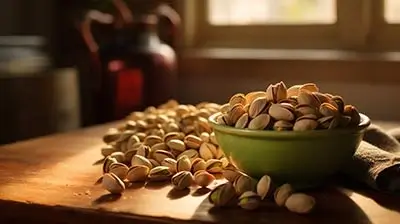
Pistachios are a type of nut with a unique flavour and a range of health benefits. There are a number of nutrients in these small green nuts, including healthy fats, protein, and fibre. In addition to being a good source of vitamins and minerals, they also contain potassium, magnesium, and vitamin B6. By lowering bad cholesterol levels and improving blood pressure, pistachios contribute to heart health. High fibre content also contributes to weight management since it reduces hunger and promotes satiety. Pistachios also contain antioxidants that protect the body from oxidative stress and inflammation.
In cooking, pistachios are a versatile ingredient that can be used in both savoury and sweet dishes. Salads, pilafs, and pesto’s would not be complete without their delightful crunch and nutty taste. In Middle Eastern cuisine, pistachios are often used as a base for desserts such as baklava and halva, where they are ground into a paste and used to make a sweet paste to be used as a base for the desserts. It is also possible to use them to decorate cakes, cookies, and ice creams, which will enhance the colour and texture of the finished product. Pistachio oil, extracted from the nuts, is a tasty and healthy alternative to other cooking oils.
Nutritional Values For Pistachios
| Name | Value |
|---|---|
| Calories (per 100 grams) | 571 |
| Protein (per 100 grams) | 21 |
| Carbs (per 100 grams) | 29 |
| Fat (per 100 grams) | 46 |
| Fibre (per 100 grams) | 11 |
| Sugar (per 100 grams) | 7.1 |
Chickpeas
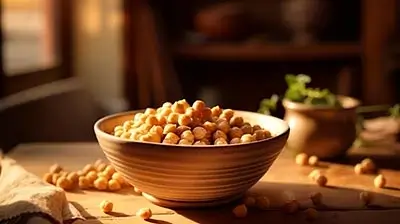
Chickpeas, also known as garbanzo beans, are a versatile and nutritious legume that have been consumed for thousands of years. Providing a wealth of vitamins and minerals, chickpeas are a high-quality source of plant-based protein and dietary fibre. Their health benefits include promoting heart health, maintaining a healthy digestive system, and managing weight. As a result of their low glycaemic index, chickpeas also help regulate blood sugar levels.
Cooking with chickpeas is incredibly versatile. Hummus, falafel, and salads are common dishes made with them in Mediterranean and Middle Eastern cuisines. You can also roast chickpeas and enjoy them as a crunchy snack or add them to soups, stews, curries, or even desserts. Their mild and nutty flavour makes them a perfect addition to a wide range of recipes, offering both taste and nutrition.
Nutritional Values For Chickpeas
| Name | Value |
|---|---|
| Calories (per 100 grams) | 429 |
| Protein (per 100 grams) | 18 |
| Carbs (per 100 grams) | 64 |
| Fat (per 100 grams) | 11 |
| Fibre (per 100 grams) | 18 |
| Sugar (per 100 grams) | 21 |
Chia Seeds
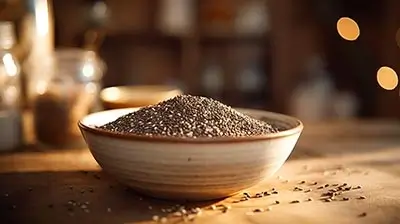
Chia seeds are small, nutrient-rich seeds derived from the Salvia Hispanic plant, native to Central and South America. The health benefits of these tiny powerhouses are numerous. First of all, chia seeds are an excellent source of omega-3 fatty acids, which support heart health and reduce inflammation. In addition, they provide digestive health benefits as well as weight loss benefits due to their fibre content. Additionally, chia seeds are loaded with antioxidants, vitamins, minerals, and protein, making them an excellent addition to any diet.
There are countless ways you can cook with chia seeds. A natural thickener, they absorb liquids and form a gel-like consistency when mixed with water. A boost of nutrition and a satisfying texture can be added to smoothies, yogurt, and oatmeal by adding pecans. Moreover, chia seeds can act as an egg substitute in vegan baking recipes due to their gel-like properties. In addition to adding a subtle crunch to salads and homemade granola bars, these seeds can also be sprinkled on chicken or fish, enhancing their nutrition value. Overall, chia seeds are a versatile and nutritious ingredient that can easily be incorporated into a wide range of recipes.
Nutritional Values For Chia Seeds
| Name | Value |
|---|---|
| Calories (per 100 grams) | 486 |
| Protein (per 100 grams) | 17 |
| Carbs (per 100 grams) | 42 |
| Fat (per 100 grams) | 31 |
| Fibre (per 100 grams) | 34 |
| Sugar (per 100 grams) | 0 |
Wild Rice

Wild rice, scientifically known as Zizania, is a nutrient-rich grain that has been a staple in Native American diets for centuries. Wild rice is actually a type of grass seed, unlike most other types of rice. A popular ingredient in a variety of dishes due to its unique nutty flavour and chewy texture. In terms of health benefits, wild rice provides protein, fibre, magnesium, phosphorus, and zinc, as well as essential minerals. It is also low in fat and cholesterol, making it a heart-healthy food choice. Wild rice is also gluten-free, so it can be consumed by those who are gluten intolerant or celiac.
In cooking, wild rice can be used in a variety of ways. Cooked and enjoyed as a side dish, added to soups, salads, or stir-fries for extra texture and flavour, or used as a stuffing for vegetables or poultry, it is versatile. Its versatility and wholesome nutritional profile make wild rice a fantastic addition to any balanced diet.
Nutritional Values For Wild Rice
| Name | Value |
|---|---|
| Calories (per 100 grams) | 357 |
| Protein (per 100 grams) | 15 |
| Carbs (per 100 grams) | 75 |
| Fat (per 100 grams) | 1.1 |
| Fibre (per 100 grams) | 6.2 |
| Sugar (per 100 grams) | 2.5 |
Soybean Sprouts

Soybean sprouts are a nutritious and versatile ingredient commonly used in various cuisines. There are many nutrients in these sprouts, including vitamins A, C, and K, as well as minerals like iron, calcium, and magnesium. Their low calorie and fat content, along with their high fibre content, makes them particularly healthy. A number of health benefits are associated with soybean sprouts, including digestion improvement, improved blood circulation, and immune system support.
In cooking, they are widely used in salads, stir-fries, soups, and as a topping for many dishes. They add freshness and depth to various recipes with their delicate, crunchy texture and mild, slightly nutty flavour.
Nutritional Values For Soybean Sprouts
| Name | Value |
|---|---|
| Calories (per 100 grams) | 122 |
| Protein (per 100 grams) | 13 |
| Carbs (per 100 grams) | 9.6 |
| Fat (per 100 grams) | 6.7 |
| Fibre (per 100 grams) | 1.1 |
| Sugar (per 100 grams) | 0 |
Edamame
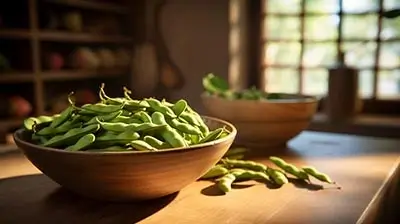
Edamame is a popular and nutritious food that has gained popularity in recent years. Often found in Asian cuisine, these young soybeans are packed with health benefits. In the first place, edamame is an excellent source of plant-based protein, making it great for vegetarians and vegans. Additionally, it contains high levels of fibre, which aids in digestion and keeps the body healthy. Edamame is also rich in vitamins and minerals, including vitamin K, folate, and iron. These nutrients contribute to bone health, red blood cell production, and overall immune function.
In terms of cooking, edamame is versatile and can be enjoyed in various ways. With a pinch of salt sprinkled on top, the pods can be served as an appetizer or snack. If you want an extra protein boost, try adding shelled edamame beans to rice or quinoa dishes, stir-fries, salads, or soups. You can also purée the beans and use them as a basis for dips, spreads, or sauces by puréeing them and blending them. The mild and slightly nutty flavour of edamame makes it a versatile ingredient that can enhance the taste and nutritional value of many dishes.
Nutritional Values For Edamame
| Name | Value |
|---|---|
| Calories (per 100 grams) | 121 |
| Protein (per 100 grams) | 12 |
| Carbs (per 100 grams) | 8.9 |
| Fat (per 100 grams) | 5/2 |
| Fibre (per 100 grams) | 5.2 |
| Sugar (per 100 grams) | 2.2 |
Black Beans
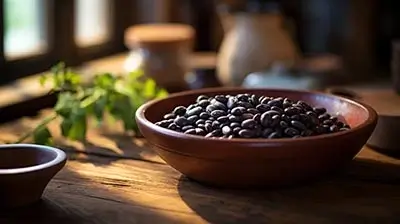
Black beans are a nutritious legume widely enjoyed for their rich flavour and versatility in cooking. In addition to being a good source of protein, fibre, and complex carbohydrates, black beans are also an excellent source of essential nutrients. A wide range of vitamins and minerals are also contained in them, including folate, iron, magnesium, and potassium. Black beans can improve heart health, digestion, and weight management.
Various cuisines worldwide use these legumes, particularly in Latin American and Caribbean cuisine. Soups, stews, salads, and even veggie burgers can be incorporated with them in a variety of ways. Furthermore, black beans can also be mashed and used as a filling for dishes such as tacos, enchiladas, or as a base for dips and spreads. With their versatility and health benefits, black beans are a staple ingredient for those seeking to maintain a balanced and nutritious diet.
Nutritional Values For Black Beans
| Name | Value |
|---|---|
| Calories (per 100 grams) | 132 |
| Protein (per 100 grams) | 8.9 |
| Carbs (per 100 grams) | 24 |
| Fat (per 100 grams) | 0.5 |
| Fibre (per 100 grams) | 8.7 |
| Sugar (per 100 grams) | 0.3 |
Kidney Beans

Kidney beans, scientifically known as Phaseolus vulgaris, are a popular legume known for their kidney-like shape and vibrant red colour. Health benefits of kidney beans go beyond their versatility as a tasty and versatile ingredient. Besides aiding in digestion, these beans promote a healthy digestive system. Moreover, they contain a great deal of plant-based protein, which means they are a perfect choice for vegetarians and vegans who are looking for a high-protein food. There are also a number of minerals that are found in kidney beans, such as iron, magnesium, and potassium, which are essential for maintaining a healthy body.
There are a variety of dishes that use kidney beans in terms of cooking, such as chili, soups, stews, and salads. Their flavour is slightly sweet and nutty, and they are a great combination with a variety of spices, herbs, and other ingredients. Kidney beans can be cooked from dried form or used conveniently from canned versions, making them a versatile and nutritious addition to any meal.
Nutritional Values For Kidney Beans
| Name | Value |
|---|---|
| Calories (per 100 grams) | 127 |
| Protein (per 100 grams) | 8.7 |
| Carbs (per 100 grams) | 23 |
| Fat (per 100 grams) | 0.5 |
| Fibre (per 100 grams) | 6.4 |
| Sugar (per 100 grams) | 0.3 |
Navy Beans

Navy beans, also known as haricot beans, are small, creamy-white beans that are highly nutritious and versatile in cooking. Beans are an excellent source of dietary fibre, which helps keep the body healthy and aids digestion. Besides being rich in protein, they also contain folate, magnesium, iron, and other vitamins and minerals. There are several health benefits associated with navy beans, including the reduction of heart disease risk, the promotion of blood sugar control, and the support of gut health.
As a cooking ingredient, navy beans are commonly used in soups, stews, and chili dishes. They can also be mashed and used as a base for spreads or dips, or added to salads and grain dishes for added texture and flavour.
Nutritional Values For Navy Beans
| Name | Value |
|---|---|
| Calories (per 100 grams) | 352 |
| Protein (per 100 grams) | 25 |
| Carbs (per 100 grams) | 63 |
| Fat (per 100 grams) | 1.1 |
| Fibre (per 100 grams) | 11 |
| Sugar (per 100 grams) | 0.4 |
Fava Beans

Fava beans, also known as broad beans, are a highly nutritious legume that offers numerous health benefits. In addition to being a good source of plant-based protein, dietary fibre, and minerals such as iron, potassium, and magnesium, these beans are also a great source of dietary fibre. Aside from their high vitamin content, fava beans are also a good source of vitamin C, vitamin K, and vitamin B. Fava beans are beneficial for heart health, blood sugar management, and digestion. In addition, their high fibre content can improve bowel movements and prevent constipation.
In terms of culinary uses, fava beans can be enjoyed in various dishes. Boil, steam, or roast them for a nutritious addition to salads, soups, stews, or pasta dishes. A creamy dip can also be made by mashing the beans or pureeing them. Overall, fava beans offer a delicious and versatile ingredient that can enhance both the taste and nutritional value of meals.
Nutritional Values For Fava Beans
| Name | Value |
|---|---|
| Calories (per 100 grams) | 88 |
| Protein (per 100 grams) | 7.9 |
| Carbs (per 100 grams) | 18 |
| Fat (per 100 grams) | 0.7 |
| Fibre (per 100 grams) | 7.5 |
| Sugar (per 100 grams) | 9.2 |
Lima Beans
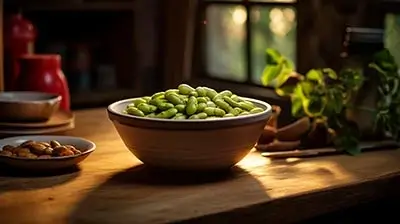
Lima beans, also known as butter beans, are a type of legume that offer a plethora of health benefits. Folate, magnesium, potassium, and dietary fibre are some of the essential nutrients found in these beans. The high fibre content of lima beans aids digestion and helps regulate blood sugar levels. Additionally, they contain antioxidants, which reduce the risk of chronic diseases and protect the body against cell damage.
In terms of cooking, lima beans are incredibly versatile. There are a wide variety of dishes that can be prepared with them, which include soups, stews, salads, and casseroles. With a creamy texture and a slightly nutty taste, they make an excellent addition to both vegetarian and meat-based recipes, thanks to their slightly creamy texture and nutty taste. Whether mashed, sautéed, or roasted, lima beans add a nutritious and delicious element to any meal.
Nutritional Values For Lima Beans
| Name | Value |
|---|---|
| Calories (per 100 grams) | 115 |
| Protein (per 100 grams) | 7.8 |
| Carbs (per 100 grams) | 21 |
| Fat (per 100 grams) | 0.4 |
| Fibre (per 100 grams) | 7 |
| Sugar (per 100 grams) | 2.9 |
Mung Beans
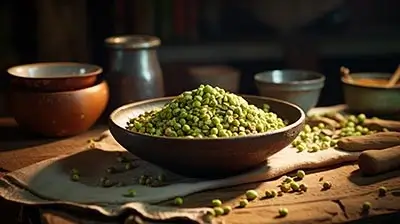
Mung beans, also known as green gram, are small, green legumes that have been cultivated for thousands of years. Besides being delicious, these beans have a variety of health benefits as well as being delicious. There are plenty of health benefits associated with them, including their high protein content, fibre content, and essential nutrients like iron, magnesium, and potassium. An excellent addition to a diet that seeks to balance out the calories and fat is mung beans because of their low calorie and fat content. Additionally, they are rich in antioxidants, which help to protect our bodies from harmful free radicals that can cause harm to our health.
The versatility of mung beans allows them to be used in many different ways when it comes to cooking. It is common to sprout these beans and add them to salads, stir-fries, and soups. A popular ingredient in Asian cuisine is mung bean paste, which is used for a variety of dishes, including desserts, dumplings, and even savoury ones. As an extra benefit, mung beans can also be ground into flour and used to make noodles, pancakes, and bread. With their versatility and nutritional benefits, incorporating mung beans into your diet can be a great way to boost your overall health.
Nutritional Values For Mung Beans
| Name | Value |
|---|---|
| Calories (per 100 grams) | 105 |
| Protein (per 100 grams) | 7 |
| Carbs (per 100 grams) | 19 |
| Fat (per 100 grams) | 0.4 |
| Fibre (per 100 grams) | 7.6 |
| Sugar (per 100 grams) | 2 |
Green Peas

Green peas, also known as garden peas, are a versatile and nutritious vegetable that provides numerous health benefits. Vitamins and minerals such as vitamin K, vitamin C, and folate are packed into these tiny little balls of goodness. Additionally, they provide fibre, which aids digestion and promotes a healthy gut. The antioxidant and anti-inflammatory properties of green peas can reduce the risk of chronic diseases and support overall health.
Green peas can be used in a variety of ways in cooking. Fresh, steamed, or boiled, they can be used as a side dish, in soups, stews, and curries, or incorporated into salads and stir-fries. You can also puree or mash them to make dips, spreads, and even fill savoury pastries. The versatility and nutritional value of green peas make them a fantastic addition to any meal.
Nutritional Values For Green Peas
| Name | Value |
|---|---|
| Calories (per 100 grams) | 84 |
| Protein (per 100 grams) | 5.4 |
| Carbs (per 100 grams) | 16 |
| Fat (per 100 grams) | 0.2 |
| Fibre (per 100 grams) | 5.5 |
| Sugar (per 100 grams) | 5.9 |
Quinoa
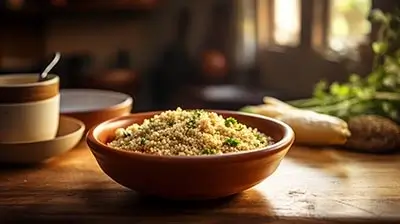
Quinoa, also known as the “superfood of the Andes,” is a highly nutritious grain-like seed that has gained popularity worldwide due to its numerous health benefits. Quinoa is rich in essential nutrients, including protein, fibre, vitamins, and minerals, making it an excellent choice for a nutritious diet. Quinoa is also gluten-free, making it suitable for individuals with gluten intolerance or following a gluten-free diet.
In terms of cooking, quinoa is incredibly versatile. There are many ways to incorporate it into meals, including salads, soups, stir-fries, and desserts. It can replace rice, couscous, or pasta. Its mild and nutty flavour adds a delightful taste to any culinary creation while providing a healthy dose of nutrients.
Nutritional Values For Quinoa
| Name | Value |
|---|---|
| Calories (per 100 grams) | 120 |
| Protein (per 100 grams) | 4.4 |
| Carbs (per 100 grams) | 21 |
| Fat (per 100 grams) | 1.9 |
| Fibre (per 100 grams) | 2.8 |
| Sugar (per 100 grams) | 0.9 |
Cannellini Beans

Cannellini beans, also known as white kidney beans, are a versatile and nutritious legume. Its creamy texture and nutty flavour have made it popular for a long time. Besides providing essential minerals such as iron, magnesium, and folate, cannellini beans are an excellent source of plant-based protein, fibre, and fibre. Additionally, they are low in fat and cholesterol, making them heart-healthy. The glycaemic index of cannellini beans is low, which means that they are a healthy option for regulating blood sugar.
These beans are commonly used in Italian cuisine for soups such as minestrone and pasta dishes such as pasta e fagioli. As well as salads, stews, dips, and spreads, these can also be used in salads, stews, dips, and spreads. Furthermore, cannellini beans can also be mashed into a puree to create a delicious and nutritious alternative to mashed potatoes in the form of a puree.
Nutritional Values For Cannellini Beans
| Name | Value |
|---|---|
| Calories (per 100 grams) | 92 |
| Protein (per 100 grams) | 4.2 |
| Carbs (per 100 grams) | 18 |
| Fat (per 100 grams) | 0.4 |
| Fibre (per 100 grams) | 5 |
| Sugar (per 100 grams) | 0.8 |
Brussels Sprouts
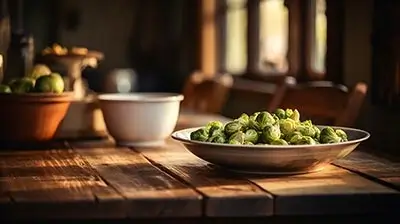
Brussels sprouts, a member of the cruciferous vegetable family, are small, green, cabbage-like vegetables that offer numerous health benefits. These nutrient-dense sprouts are a great source of vitamins C and K, as well as folate, fibre, and antioxidants. Consuming Brussels sprouts can support a strong immune system, promote bone health, aid in digestion, and reduce the risk of chronic diseases.
When it comes to cooking, Brussels sprouts can be prepared in various ways. They can be roasted, sautéed, steamed, or even enjoyed raw in salads. Popular cooking methods often involve adding Flavors like garlic, lemon, bacon, or balsamic vinegar to enhance their taste. Whether it’s in stir-fries, side dishes, or as a main course ingredient, Brussels sprouts make for a versatile and nutritious addition to any meal.
Nutritional Values For Brussels Sprouts
| Name | Value |
|---|---|
| Calories (per 100 grams) | 43 |
| Protein (per 100 grams) | 3.4 |
| Carbs (per 100 grams) | 9 |
| Fat (per 100 grams) | 0.3 |
| Fibre (per 100 grams) | 3.8 |
| Sugar (per 100 grams) | 2.2 |
Artichokes (Globe or French)
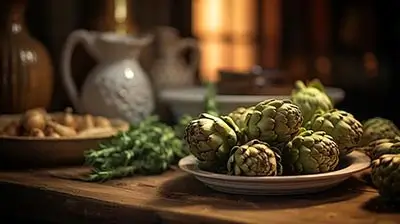
Artichokes, be it Globe or French, are a unique and versatile vegetable that offer numerous health benefits. Fibre, vitamins C and K, as well as potassium and magnesium, make them excellent sources of nutrients. Artichokes are known for their high antioxidant content, which helps protect against oxidative stress and inflammation in the body. Additionally, they contain compounds that support the health of the liver as well as aid in digestion.
In the kitchen, there are several ways in which you can prepare and enjoy artichokes. You can roast, grill, or steam the hearts and tender inner leaves and add them to salads, dips, or pizzas. Their unique and delicious flavour can also be imparted to soups and stews when stuffed, baked, or added to them. Furthermore, artichoke leaves can be boiled, and the flesh scraped off to create a delicious dip or sauce.
Nutritional Values For Artichokes
| Name | Value |
|---|---|
| Calories (per 100 grams) | 47 |
| Protein (per 100 grams) | 3.3 |
| Carbs (per 100 grams) | 11 |
| Fat (per 100 grams) | 0.2 |
| Fibre (per 100 grams) | 5.4 |
| Sugar (per 100 grams) | 1 |
Oyster Mushrooms

Oyster mushrooms, scientifically known as Pleurotus ostreatus, are a popular edible mushroom with a delicate flavour and a unique oyster-like appearance. The health benefits associated with these mushrooms go beyond their delicious taste. Low in calories and fat, oyster mushrooms are an excellent addition to a healthy diet. Vitamins (including B vitamins, vitamin D, and vitamin C), and minerals (including potassium, phosphorus, and copper) can be found in them as well. As well as antioxidants and compounds that are anti-inflammatory and immune-boosting, they contain compounds that may help boost the body’s defences. Oyster mushrooms have been linked to various health benefits, including improved heart health, reduced inflammation, and enhanced digestion.
In the culinary world, oyster mushrooms are highly versatile and can be used in various dishes. They have a mild, nutty taste that is complementary to many other ingredients. There are many ways to prepare oyster mushrooms, including sauteing, stir-frying, roasting, grilling, or even using them raw. As a vegetarian or vegan substitute for meat in dishes like stir-fries, stews, and pasta sauces, they have a unique, meaty texture. Flavour-absorbent, they can be seasoned with herbs, spices, and sauces to create a range of delicious dishes. Whether used as a main ingredient or an addition to a dish, oyster mushrooms offer a satisfying taste.
Nutritional Values For Oyster Mushrooms
| Name | Value |
|---|---|
| Calories (per 100 grams) | 33 |
| Protein (per 100 grams) | 3.3 |
| Carbs (per 100 grams) | 6.1 |
| Fat (per 100 grams) | 0.4 |
| Fibre (per 100 grams) | 2.3 |
| Sugar (per 100 grams) | 1.1 |
Sweet Corn

Sweet corn is a popular and delicious vegetable that is loved for its naturally sweet and juicy kernels. Apart from being a tasty addition to meals, it also offers several health benefits. Firstly, sweet corn is a great source of dietary fibre, which helps to improve digestion and prevent constipation. As well as being rich in vitamins and minerals such as vitamin C, vitamin B6, and potassium, it contributes to your overall health and immune system. As well as containing antioxidants, sweet corn also protects the body against free radicals and reduces chronic disease risk.
You can enjoy sweet corn in a variety of ways when it comes to cooking. For its natural sweetness, it can be boiled, steamed, grilled, or even roasted. In addition to salads, soups, and stir-fries, you can also make salsas, fritters, or cornbread with it.
Nutritional Values For Sweet Corn
| Name | Value |
|---|---|
| Calories (per 100 grams) | 86 |
| Protein (per 100 grams) | 3.3 |
| Carbs (per 100 grams) | 19 |
| Fat (per 100 grams) | 1.4 |
| Fibre (per 100 grams) | 2 |
| Sugar (per 100 grams) | 6.3 |
Button Mushrooms
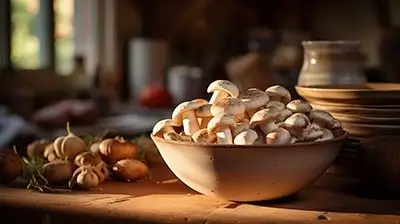
Button mushrooms, scientifically known as Agaricus bisporus, are a popular and versatile type of mushroom that is widely used in cooking. Suitable for a variety of dishes, these small, white mushrooms have a mild, earthy flavour. Buttons mushrooms also have several health benefits in addition to their culinary appeal. Buttons mushrooms also have several health benefits in addition to their culinary appeal. They have essential nutrients like vitamins B and D, antioxidants, and minerals such as selenium and potassium. Numerous health benefits are associated with these nutrients, such as boosting the immune system, promoting brain health, and reducing chronic disease risk.
In cooking, button mushrooms can be enjoyed raw in salads or used in various recipes such as soups, stir-fries, pasta dishes, and omelettes. They can be sautéed, grilled, stuffed, or even pickled, adding a delightful texture and flavour to the dishes they are incorporated into.
Nutritional Values For Button Mushrooms
| Name | Value |
|---|---|
| Calories (per 100 grams) | 22 |
| Protein (per 100 grams) | 3.1 |
| Carbs (per 100 grams) | 3.3 |
| Fat (per 100 grams) | 0.3 |
| Fibre (per 100 grams) | 1 |
| Sugar (per 100 grams) | 2 |
Kale
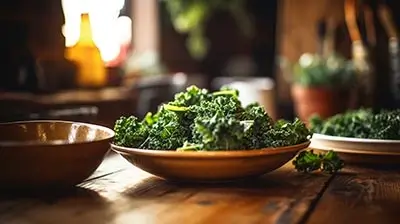
Kale is a leafy green vegetable that belongs to the cruciferous family, along with cabbage, broccoli, and Brussels sprouts. Its multitude of health benefits make it a nutrient-dense powerhouse. Kale is an excellent source of vitamins A, C, and K, as well as minerals like calcium, potassium, and iron. Additionally, it contains antioxidants that help prevent oxidative stress and inflammation. Kale consumption has been linked to improved heart health, improved digestion, and enhanced immunity. Due to its high content of fibre, it contributes to the healthy management of weight and aids in digestion.
The versatility of kale can be seen in the many different ways it can be used in cooking. You can use it as a salad ingredient, as a side dish, in soups, stews, and stir-fries, or you can sauté it to serve as a side dish. The leaves can also be blended into smoothies or baked into crispy kale chips as a nutritious snack option.
Nutritional Values For Kale
| Name | Value |
|---|---|
| Calories (per 100 grams) | 35 |
| Protein (per 100 grams) | 2.9 |
| Carbs (per 100 grams) | 4.4 |
| Fat (per 100 grams) | 1.5 |
| Fibre (per 100 grams) | 4.1 |
| Sugar (per 100 grams) | 1 |
Spinach
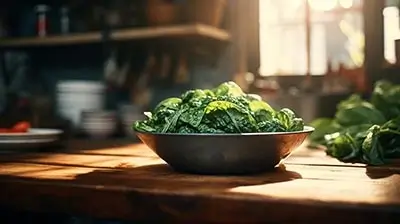
Spinach, a leafy green vegetable packed with nutrients, is widely known for its numerous health benefits. Superfoods like this are great sources of vitamins A, C, and K, as well as iron and calcium. These nutrients contribute to healthy bones, promote good vision, support the immune system, and aid in blood clotting. The antioxidants in spinach can also reduce oxidative stress in the body, potentially reducing chronic disease risks.
Spinach is incredibly versatile when it comes to cooking. Raw or blended, it provides an instant nutrition boost to salads and smoothies. It can also be sautéed, steamed, or blanched and incorporated into various dishes like soups, stews, pastas, and stir-fries. A variety of ingredients can be paired with its mild flavour, making it a valuable addition to any kitchen.
Nutritional Values For Spinach
| Name | Value |
|---|---|
| Calories (per 100 grams) | 23 |
| Protein (per 100 grams) | 2.9 |
| Carbs (per 100 grams) | 3.6 |
| Fat (per 100 grams) | 0.4 |
| Fibre (per 100 grams) | 2.2 |
| Sugar (per 100 grams) | 0.4 |
Broccoli

Broccoli is a nutrient-packed vegetable that belongs to the cruciferous family. It is regarded as one of the healthiest vegetables due to its many health benefits. In addition to being packed with vitamins, minerals, and fibre, broccoli is also an excellent source of fibre. A rich source of vitamin C, it boosts the immune system and acts as an antioxidant. Also, broccoli contains vitamin K, an important nutrient for bone health and blood clotting. It also provides folate, potassium, and other essential nutrients. Moreover, broccoli is known to possess cancer-fighting properties due to the presence of compounds like sulforaphane.
As far as cooking goes, broccoli has a very wide variety of uses. Raw or steamed, roasted, stir-fried, or blended into soups and purees, it can be enjoyed raw in salads. A delicious and healthy addition to many dishes, its slightly bitter and earthy flavour pairs well with various ingredients.
Nutritional Values For Broccoli
| Name | Value |
|---|---|
| Calories (per 100 grams) | 34 |
| Protein (per 100 grams) | 2.8 |
| Carbs (per 100 grams) | 6.6 |
| Fat (per 100 grams) | 0.4 |
| Fibre (per 100 grams) | 2.6 |
| Sugar (per 100 grams) | 1.7 |
Asparagus

Asparagus is a versatile and nutritious vegetable that belongs to the lily family. The stalks are tender and have a distinct taste. As well as being delicious, asparagus has a variety of health benefits. As well as providing vitamins A, C, E, and K, Asparagus is a good source of folate and dietary fibre. It is also rich in antioxidants, which may help reduce the risk of chronic diseases by protecting the body against free radicals. It is also low in calories and contains no fat or cholesterol, making asparagus a great weight management food.
Asparagus can be prepared and cooked in various ways, allowing for a wide range of culinary possibilities. Asparagus is most commonly cooked by steaming or boiling, which retains its vibrant green colour and preserves its nutritional value. Roasting is another popular technique that enhances the vegetable’s natural sweetness and adds a delightful crispness to the stalks. Asparagus can also be stir-fried, grilled, or even used raw in salads. Its mild and slightly earthy flavour pairs well with various seasonings, such as garlic, lemon, herbs, and olive oil. No matter how asparagus is served, whether as a side dish, incorporated into pasta or risotto, or used in soups or omelettes, asparagus adds a refreshing and nutritious element to any meal.
Nutritional Values For Asparagus
| Name | Value |
|---|---|
| Calories (per 100 grams) | 20 |
| Protein (per 100 grams) | 2.2 |
| Carbs (per 100 grams) | 3.9 |
| Fat (per 100 grams) | 0.1 |
| Fibre (per 100 grams) | 2.1 |
| Sugar (per 100 grams) | 1.9 |
Potatoes (Baked)

Baked potatoes are a versatile and delicious food choice that offers various health benefits. These starchy tubers are a rich source of carbohydrates, providing energy for the body. In addition, they contain dietary fibre, which promotes a healthy digestive system. Vitamin C, potassium, and vitamin B6 found in potatoes support immune function, maintain healthy blood pressure levels, and assist in brain development.
In cooking, baked potatoes can be enjoyed in numerous ways. They can be topped with a variety of ingredients, like sour cream, cheese, bacon, and chives, making them a satisfying and customizable dish. You can also create potato skins from baked potatoes, a popular appetizer, or mash them to make creamy side dishes. Baked potatoes are versatile and nutritious ingredients that can be incorporated into a balanced and flavourful diet.
Nutritional Values For Potatoes (Baked)
| Name | Value |
|---|---|
| Calories (per 100 grams) | 92 |
| Protein (per 100 grams) | 2.1 |
| Carbs (per 100 grams) | 21 |
| Fat (per 100 grams) | 0.2 |
| Fibre (per 100 grams) | 2.1 |
| Sugar (per 100 grams) | 1.5 |
Avocado
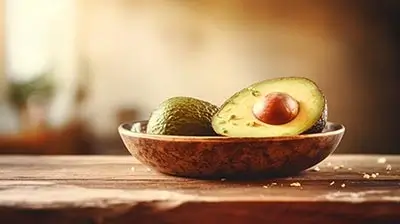
Avocado, also known as the “alligator pear,” is a versatile fruit that offers numerous health benefits. Avocados are loaded with healthy fats, fibre, and essential nutrients that lower bad cholesterol levels and reduce the risk of heart disease. They are also a great source of B vitamins, vitamin K, and vitamin E, which are great for good health, a healthy immune system, and proper nerve function. Additionally, avocados contain antioxidants that help protect the body against inflammation and oxidative stress.
Avocados can be used in a wide variety of cooking methods. In salads, sandwiches, and wraps, they add a creamy texture and a rich, buttery flavour. Avocados are the main ingredient in guacamole, a popular Mexican dip you can eat with tortilla chips or add to tacos. You can also blend avocado into smoothies for a nutritious boost, spread it on toast, or use it in baking instead of butter or mayonnaise. It’s a great ingredient for dips, dressings, and even desserts like avocado chocolate mousse. Generally speaking, avocados are a delicious and versatile addition to any meal, and offer a lot of health benefits as well.
Nutritional Values For Avocado
| Name | Value |
|---|---|
| Calories (per 100 grams) | 160 |
| Protein (per 100 grams) | 2 |
| Carbs (per 100 grams) | 8.5 |
| Fat (per 100 grams) | 15 |
| Fibre (per 100 grams) | 6.7 |
| Sugar (per 100 grams) | 0.7 |
Cauliflower

Cauliflower, a versatile and nutritious vegetable, is a member of the cruciferous family, known for its numerous health benefits. The nutritional value of cauliflower makes it an excellent addition to a diet that’s balanced in vitamins, minerals, and fibre. A good source of vitamin C, it boosts the immune system and promotes collagen production in the skin. As well as folate, it contains vitamin K, which is essential to bone health, and folate, which is crucial for cell growth and development. In addition to being rich in antioxidants, cauliflower also contains glucosinolates, which have been linked to a reduced risk of cancer.
There are endless possibilities when it comes to cooking cauliflower. It can be enjoyed raw as a crunchy addition to salads or as a dipper for hummus and other spreads. Steaming, roasting, boiling, or sauteing are all ways to cook it. Low-carb cauliflower rice has become a popular alternative to traditional rice, and cauliflower florets can replace chicken in vegetarian buffalo wings or blended into creamy soups. Moreover, cauliflower can be transformed into a gluten-free pizza crust or mashed as a healthier substitute for mashed potatoes. Cauliflower’s mild taste and ability to absorb flavours make it a versatile ingredient that can be used in a variety of dishes.
Nutritional Values For Cauliflower
| Name | Value |
|---|---|
| Calories (per 100 grams) | 25 |
| Protein (per 100 grams) | 1.9 |
| Carbs (per 100 grams) | 5 |
| Fat (per 100 grams) | 0.3 |
| Fibre (per 100 grams) | 2 |
| Sugar (per 100 grams) | 1.9 |
Turnip Greens
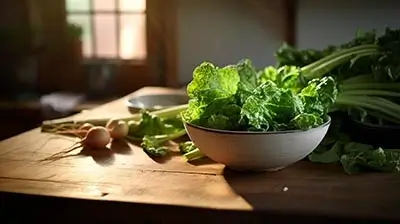
Turnip greens are the leafy tops of the turnip plant and are commonly consumed as a nutritious vegetable. Vitamins A, C, and K, as well as calcium, iron, and fibre, are abundant in them. Health benefits of these greens include boosting the immune system, promoting healthy digestion, and improving bone density. The high antioxidant content of turnip greens may also reduce the risk of chronic diseases such as heart disease and cancer.
Turnip greens can be prepared in a variety of ways when it comes to cooking. You can sauté them, steam them, or boil them, and add them to soups, stews, or include them in salads or smoothies. Adding turnip greens to a variety of recipes makes them a versatile and flavourful addition.
Nutritional Values For Turnip Greens
| Name | Value |
|---|---|
| Calories (per 100 grams) | 32 |
| Protein (per 100 grams) | 1.5 |
| Carbs (per 100 grams) | 7.1 |
| Fat (per 100 grams) | 0.3 |
| Fibre (per 100 grams) | 3.2 |
| Sugar (per 100 grams) | 0.8 |
Frequently Asked Questions
What are the potential side effects of consuming too much protein through vegetables?
We’ve found that consuming too much protein, even from vegetables, might lead to potential side effects. These can include digestive issues like bloating and constipation due to the high fiber content in veggies.
Additionally, a high-protein diet may strain your kidneys over time, particularly if you have pre-existing kidney conditions.
Always remember: while protein is essential for our bodies, it’s crucial to maintain a balanced diet and consume nutrients in moderation.
Can I get enough protein from vegetables to replace meat entirely?
Absolutely, we can get enough protein from vegetables to replace meat. However, it requires mindful planning to ensure all essential amino acids are consumed.
Vegetables such as lentils, peas, spinach, and broccoli are rich in protein. Combining different plant proteins throughout the day can provide a complete protein profile.
But remember, it’s not just about protein – balance with other nutrients is crucial too for overall health. Consultation with a nutritionist could help in designing an effective diet plan.
Are there any vegetables that should be avoided due to their protein content?
Actually, there aren’t any vegetables we need to avoid due to their protein content. Proteins are essential nutrients for the body. They’re needed for building and repairing tissues, making enzymes, hormones, and other bodily chemicals. It’s more a concern of balancing your total protein intake with other nutrients. If you’re consuming a variety of vegetables along with grains and legumes, you’ll likely get a sufficient blend of all necessary amino acids without overdoing it on protein.
How can I incorporate more high-protein vegetables into my diet?
We can easily add more high-protein vegetables into our diet by making some simple changes. Let’s start by swapping out traditional pasta for lentil or chickpea pasta, both of which are packed with protein.
We can also add peas, spinach, and broccoli to our salads, stir-fries, and soups.
Lastly, consider snacking on edamame or using it in salads - it’s versatile and full of protein.
Remember, variety is key to a well-balanced diet.
Do cooking methods affect the protein content of vegetables?
Yes, cooking methods can impact the protein content of vegetables. Heat can break down some proteins, making them less available for our bodies to use. We know that boiling vegatables is known to leach nutrients into the water, potentially reducing protein levels.
However, cooking can also make certain nutrients more digestible. So while it’s true that cooking may reduce some protein content, it doesn’t eliminate it entirely and can even enhance other nutrient absorption.
Final Thoughts
We’ve seen that vegetables can be a surprising source of protein. It’s crucial to incorporate these high-protein veggies into our diet, especially if we’re reducing our meat intake.
We should strive for variety and balance in our meals to ensure we’re getting enough protein daily. Remember, every bit counts towards maintaining our health and wellbeing.
Let’s make the most out of nature’s bounty and let us know how you get on with adding some of these protein rich vegetables to your cooking!


